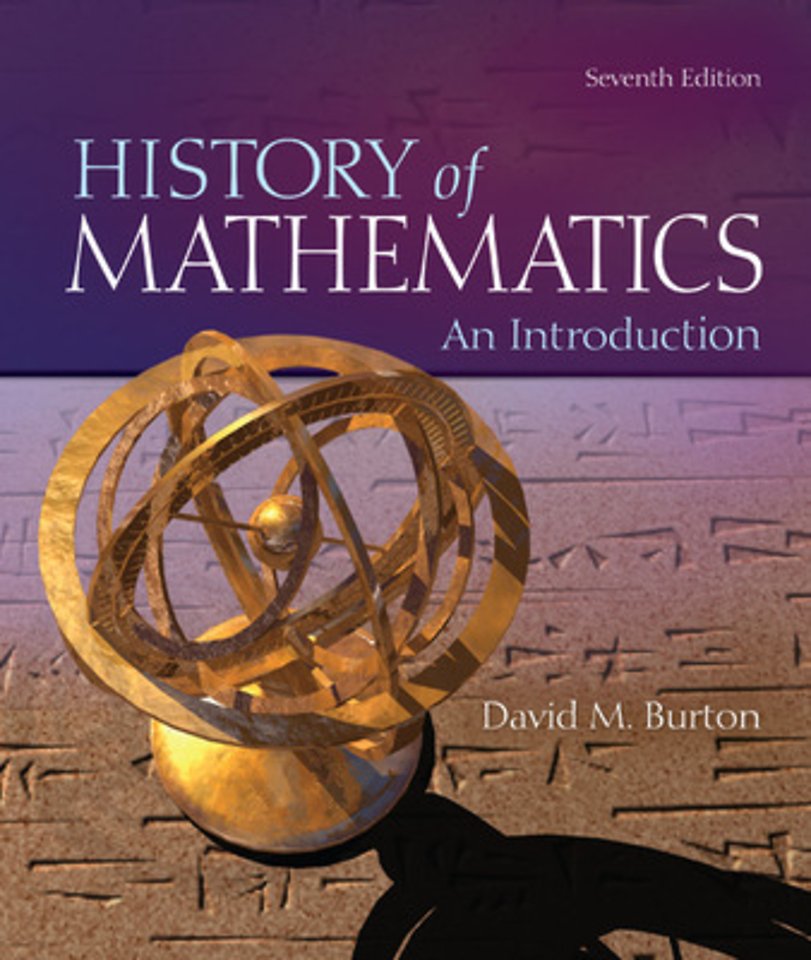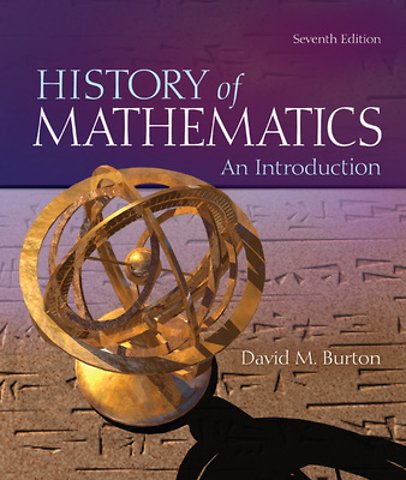<h1> The History of Mathematics: An Introduction, 7e by David M. Burton </h1><h2> Preface </h2><h2> 1Early Number Systems and Symbols </h2><h4> 1.1 </h4><h4> Primitive Counting </h4><h4> A Sense of Number </h4><h4> Notches as Tally Marks </h4><h4> The Peruvian Quipus: Knots as Numbers </h4><h4> 1.2 </h4><h4> Number Recording of the Egyptians and Greeks </h4> <h4> The History of Herodotus </h4> <h4> Hieroglyphic Representation of Numbers </h4><h4> Egyptian Hieratic Numeration </h4> <h4> The Greek Alphabetic Numeral System </h4> <h4> 1.3 </h4> <h4> Number Recording of the Babylonians </h4> <h4> Babylonian Cuneiform Script </h4><h4> Deciphering Cuneiform: Grotefend and Rawlinson </h4><h4> The Babylonian Positional Number System </h4> <h4> Writing in Ancient China </h4> <h2> 2 Mathematics in Early Civilizations </h2> <h4> 2.1 </h4> <h4> The Rhind Papyrus </h4> <h4> Egyptian Mathematical Papyri </h4> <h4> A Key to Deciphering: The Rosetta Stone </h4> <h4> 2.2 </h4> <h4> Egyptian Arithmetic </h4> <h4> Early Egyptian Multiplication </h4><h4> The Unit Fraction Table </h4> <h4> Representing Rational Numbers </h4> <h4> 2.3 </h4> <h4> Four Problems from the Rhind Papyrus </h4> <h4> The Method of False Position </h4> <h4> A Curious Problem </h4> <h4> Egyptian Mathematics as Applied Arithmetic </h4> <h4> 2.4 </h4> <h4> Egyptian Geometry </h4><h4> Approximating the Area of a Circle </h4> <h4> The Volume of a Truncated Pyramid </h4> <h4> Speculations About the Great Pyramid </h4> <h4> 2.5 </h4> <h4> Babylonian Mathematics </h4> <h4> A Tablet of Reciprocals </h4> <h4> The Babylonian Treatment of Quadratic Equations </h4> <h4> Two Characteristic Babylonian Problems </h4> <h4> 2.6 </h4> <h4> Plimpton </h4> <h4> A Tablet Concerning Number Triples </h4> <h4> Babylonian Use of the Pythagorean Theorem </h4> <h4> The Cairo Mathematical Papyrus </h4> <h2> 3 The Beginnings of Greek Mathematics </h2> <h4> 3.1 </h4> <h4> The Geometric Discoveries of Thales </h4> <h4> Greece and the Aegean Area </h4> <h4> The Dawn of Demonstrative Geometry: Thales of Miletos </h4> <h4> Measurements Using Geometry </h4> <h4> 3.2 </h4> <h4> Pythagorean Mathematics </h4> <h4> Pythagoras and His Followers </h4> <h4> Nichomachus' Introductio Arithmeticae </h4> <h4> The Theory of Figurative Numbers </h4> <h4> Zeno's Paradox </h4> <h4> 3.3 </h4> <h4> The Pythagorean Problem </h4> <h4> Geometric Proofs of the Pythagorean Theorem </h4> <h4> Early Solutions of the Pythagorean Equation </h4> <h4> The Crisis of Incommensurable Quantities </h4> <h4> Theon's Side and Diagonal Numbers </h4> <h4> Eudoxus of Cnidos </h4> <h4> 3.4 </h4> <h4> Three Construction Problems of Antiquity </h4> <h4> Hippocrates and the Quadrature of the Circle </h4> <h4> The Duplication of the Cube </h4> <h4> The Trisection of an Angle </h4> <h4> 3.5 <h4> The Quadratrix of Hippias </h4> <h4> Rise of the Sophists </h4> <h4> Hippias of Elis </h4> <h4> The Grove of Academia: Plato's Academy </h4> <h2> 4 The Alexandrian School: Euclid </h2> <h4> 4.1 </h4> <h4> Euclid and the Elements </h4> <h4> A Center of Learning: The Museum </h4> <h4> Euclid's Life and Writings </h4> <h4> 4.2 </h4> <h4> Euclidean Geometry </h4> <h4> Euclid's Foundation for Geometry </h4> <h4> Book I of the Elements </h4><h4> Euclid's Proof of the Pythagorean Theorem </h4><h4> Book II on Geometric Algebra </h4> <h4> Construction of the Regular Pentagon </h4> <h4> 4.3 </h4> <h4> Euclid's Number Theory </h4> <h4> Euclidean Divisibility Properties </h4> <h4> The Algorithm of Euclid </h4> <h4> The Fundamental Theorem of Arithmetic </h4> <h4> An Infinity of Primes </h4> <h4> 4.4 </h4> <h4> Eratosthenes, the Wise Man of Alexandria </h4> <h4> The Sieve of Eratosthenes </h4> <h4> Measurement of the Earth </h4> <h4> The Almagest of Claudius Ptolemy </h4> <h4> Ptolemy's Geographical Dictionary </h4> <h4> 4.5 </h4> <h4> Archimedes </h4> <h4> The Ancient World's Genius </h4> <h4> Estimating the Value of π </h4> <h4> The Sand-Reckoner </h4> <h4> Quadrature of a Parabolic Segment </h4> <h4> Apollonius of Perga: The Conics </h4> <h2> 5 The Twilight of Greek Mathematics: Diophantus </h2> <h4> 5.1 </h4> <h4> The Decline of Alexandrian Mathematics </h4> <h4> The Waning of the Golden Age </h4> <h4> The Spread of Christianity </h4> <h4> Constantinople, A Refuge for Greek Learning </h4> <h4> 5.2 </h4> <h4> The Arithmetica </h4> <h4> Diophantus's Number Theory </h4> <h4> Problems from the Arithmetica </h4> <h4> 5.3 </h4> <h4> Diophantine Equations in Greece, India, and China </h4> <h4> The Cattle Problem of Archimedes </h4> <h4> Early Mathematics in India </h4><h4> The Chinese Hundred Fowls Problem </h4> <h4> 5.4 </h4> <h4> The Later Commentators </h4> <h4> The Mathematical Collection of Pappus </h4> <h4> Hypatia, the First Woman Mathematician </h4> <h4> Roman Mathematics: Boethius and Cassiodorus </h4> <h4> 5.5 </h4> <h4> Mathematics in the Near and Far East </h4> <h4> The Algebra of al-Khowârizmî </h4> <h4> Abû Kamil and Thâbit ibn Qurra </h4> <h4> Omar Khayyam </h4> <h4> The Astronomers al-Tusi and al-Karashi </h4> <h4> The Ancient Chinese Nine Chapters </h4> <h4> Later Chinese Mathematical Works </h4> <h2> 6 The First Awakening: Fibonacci </h2> <h4> 6.1 </h4> <h4> The Decline and Revival of Learning </h4> <h4> The Carolingian Pre-Renaissance </h4> <h4> Transmission of Arabic Learning to the West </h4> <h4> The Pioneer Translators: Gerard and Adelard </h4> <h4> 6.2 </h4> <h4> The Liber Abaci and Liber Quadratorum </h4> <h4> The Hindu-Arabic Numerals </h4> <h4> Fibonacci's Liver Quadratorum </h4> <h4> The Works of Jordanus de Nemore </h4> <h4> 6.3 </h4> <h4> The Fibonacci Sequence </h4> <h4> The Liber Abaci's Rabbit Problem </h4> <h4> Some Properties of Fibonacci Numbers </h4> <h4> 6.4 </h4> <h4> Fibonacci and the Pythagorean Problem </h4> <h4> Pythagorean Number Triples </h4> <h4> Fibonacci's Tournament Problem </h4> <h2> 7 The Renaissance of Mathematics: Cardan and Tartaglia </h2> <h4> 7.1 </h4> <h4> Europe in the Fourteenth and Fifteenth Centuries </h4> <h4> The Italian Renaissance </h4> <h4> Artificial Writing: The Invention of Printing </h4> <h4> Founding of the Great Universities </h4> <h4> A Thirst for Classical Learning </h4> <h4> 7.2 </h4> <h4> The Battle of the Scholars </h4><h4> Restoring the Algebraic Tradition: Robert Recorde </h4><h4> The Italian Algebraists: Pacioli, del Ferro and Tartaglia </h4><h4> Cardan, A Scoundrel Mathematician </h4> <h4> 7.3 </h4> <h4> Cardan's Ars Magna </h4> <h4> Cardan's Solution of the Cubic Equation </h4> <h4> Bombelli and Imaginary Roots of the Cubic </h4> <h4> 7.4 </h4> <h4> Ferrari's Solution of the Quartic Equation </h4> <h4> The Resolvant Cubic </h4> <h4> The Story of the Quintic Equation: Ruffini, Abel and Galois </h4> <h2> 8 The Mechanical World: Descartes and Newton </h2> <h4> 8.1 </h4><h4> The Dawn of Modern Mathematics </h4> <h4> The Seventeenth Century Spread of Knowledge </h4> <h4> Galileo's Telescopic Observations </h4> <h4> The Beginning of Modern Notation: Francois Vièta </h4> <h4> The Decimal Fractions of Simon Steven </h4> <h4> Napier's Invention of Logarithms </h4> <h4> The Astronomical Discoveries of Brahe and Kepler </h4> <h4> 8.2 </h4><h4> Descartes: The Discours de la Méthod </h4> <h4> The Writings of Descartes </h4> <h4> Inventing Cartesian Geometry </h4> <h4> The Algebraic Aspect of La Géometrie </h4> <h4> Descartes' Principia Philosophia </h4> <h4> Perspective Geometry: Desargues and Poncelet </h4> <h4> 8.3 </h4> <h4> Newton: The Principia Mathematica </h4><h4> The Textbooks of Oughtred and Harriot </h4> <h4> Wallis' Arithmetica Infinitorum </h4> <h4> The Lucasian Professorship: Barrow and Newton </h4> <h4> Newton's Golden Years </h4> <h4> The Laws of Motion </h4> <h4> Later Years: Appointment to the Mint </h4> <h4> 8.4 </h4> <h4> Gottfried Leibniz: The Calculus Controversy </h4> <h4> The Early Work of Leibniz </h4> <h4> Leibniz's Creation of the Calculus </h4> <h4> Newton's Fluxional Calculus </h4> <h4> The Dispute over Priority </h4><h4> Maria Agnesi and Emilie du Châtelet </h4> <h2> 9 The Development of Probability Theory: Pascal, Bernoulli, and Laplace </h2> <h4> 9.1 </h4> <h4> The Origins of Probability Theory </h4> <h4> Graunt's Bills of Mortality </h4> <h4> Games of Chance: Dice and Cards </h4> <h4> The Precocity of the Young Pascal </h4> <h4> Pascal and the Cycloid </h4> <h4> De Méré's Problem of Points </h4> <h4> 9.2 </h4> <h4> Pascal's Arithmetic Triangle </h4> <h4> The Traité du Triangle Arithmétique </h4> <h4> Mathematical Induction </h4><h4> Francesco Maurolico's Use of Induction </h4> <h4> 9.3 </h4> <h4> The Bernoullis and Laplace </h4> <h4> Christiaan Huygens's Pamphlet on Probability </h4> <h4> The Bernoulli Brothers: John and James </h4> <h4> De Moivre's Doctrine of Chances </h4> <h4> The Mathematics of Celestial Phenomena: Laplace </h4> <h4> Mary Fairfax Somerville </h4> <h4> Laplace's Research on Probability Theory </h4> <h4> Daniel Bernoulli, Poisson, and Chebyshev </h4> <h2> 10 The Revival of Number Theory: Fermat, Euler, and Gauss </h2> <h4> 10.1 </h4><h4> Martin Mersenne and the Search for Perfect Numbers </h4><h4> Scientific Societies </h4> <h4> Marin Mersenne's Mathematical Gathering </h4> <h4> Numbers, Perfect and Not So Perfect </h4> <h4> 10.2 </h4><h4> From Fermat to Euler </h4> <h4> Fermat's Arithmetica </h4> <h4> The Famous Last Theorem of Fermat </h4> <h4> The Eighteenth-Century Enlightenment </h4> <h4> Maclaurin's Treatise on Fluxions </h4> <h4> Euler's Life and Contributions </h4> <h4> 10.3 </h4> <h4> The Prince of Mathematicians: Carl Friedrich Gauss </h4> <h4> The Period of the French Revolution: Lagrange, Monge, and Carnot </h4><h4> Gauss's Disquisitiones Arithmeticae </h4> <h4> The Legacy of Gauss: Congruence Theory </h4> <h4> Dirichlet and Jacobi </h4> <h2> 11 Nineteenth-Century Contributions: Lobachevsky to Hilbert </h2> <h4> 11.1 </h4> <h4> Attempts to Prove the Parallel Postulate </h4> <h4> The Efforts of Proclus, Playfair, and Wallis </h4>
<h4> Saccheri Quadrilaterals </h4> <h4> The Accomplishments of Legendre </h4> <h4> Legendre's Eléments de géometrie </h4> <h4> 11.2 </h4> <h4> The Founders of Non-Euclidean Geometry </h4> <h4> Gauss's Attempt at a New Geometry </h4> <h4> The Struggle of John Bolyai </h4> <h4> Creation of Non-Euclidean Geometry: Lobachevsky </h4> <h4> Models of the New Geometry: Riemann, Beltrami, and Klein </h4> <h4> Grace Chisholm Young </h4> <h4> 11.3 </h4> <h4> The Age of Rigor </h4> <h4> D'Alembert and Cauchy on Limits </h4> <h4> Fourier's Series </h4> <h4> The Father of Modern Analysis, Weierstrass </h4> <h4> Sonya Kovalevsky </h4> <h4> The Axiomatic Movement: Pasch and Hilbert </h4> <h4> 11.4 </h4><h4> Arithmetic Generalized </h4><h4> Babbage and the Analytical Engine </h4><h4> Peacock's Treatise on Algebra </h4> <h4> The Representations of Complex Numbers </h4> <h4> Hamilton's Discovery of Quaternions </h4> <h4> Matrix Algebra: Cayley and Sylvester </h4> <h4> Boole's Algebra of Logic </h4> <h2> 12Transition to the Twenthieth Century: Cantor and Kronecker </h2> <h4> 12.1 </h4> <h4> The Emergence of American Mathematics </h4> <h4> Ascendency of the German Universities </h4> <h4> American Mathematics Takes Root: 1800-1900 </h4> <h4> The Twentieth Century Consolidation </h4> <h4> 12.2 </h4> <h4> Counting the Infinite </h4> <h4> The Last Universalist: Poincaré </h4> <h4> Cantor's Theory of Infinite Sets </h4> <h4> Kronecker's View of Set Theory </h4> <h4> Countable and Uncountable Sets </h4> <h4> Transcendental Numbers </h4> <h4> The Continuum Hypothesis </h4> <h4> 12.3 </h4> <h4> The Paradoxes of Set Theory </h4><h4> The Early Paradoxes </h4> <h4> Zermelo and the Axiom of Choice </h4> <h4> The Logistic School: Frege, Peano and Russell </h4> <h4> Hilbert's Formalistic Approach </h4><h4> Brouwer's Intuitionism </h4><h2> 13 Extensions and Generalizations: Hardy, Hausdorff, and Noether </h2> <h4> 13.1 </h4> <h4> Hardy and Ramanujan </h4> <h4> The Tripos Examination </h4> <h4> The Rejuvenation of English Mathematics </h4> <h4> A Unique Collaboration: Hardy and Littlewood </h4> <h4> India's Prodigy, Ramanujan </h4> <h4> 13.2 </h4> <h4> The Beginnings of Point-Set Topology </h4> <h4> Frechet's Metric Spaces </h4> <h4> The Neighborhood Spaces of Hausdorff </h4> <h4> Banach and Normed Linear Spaces </h4> <h4> 13.3 </h4> <h4> Some Twentieth-Century Developments </h4> <h4> Emmy Noether's Theory of Rings </h4> <h4> Von Neumann and the Computer </h4> <h4> Women in Modern Mathematics </h4> <h4> A Few Recent Advances </h4> <h2> General Bibliography </h2> <h2> Additional Reading </h2><h2> The Greek Alphabet </h2> <h2> Solutions to Selected Problems </h2> <h2> Index </h2>

